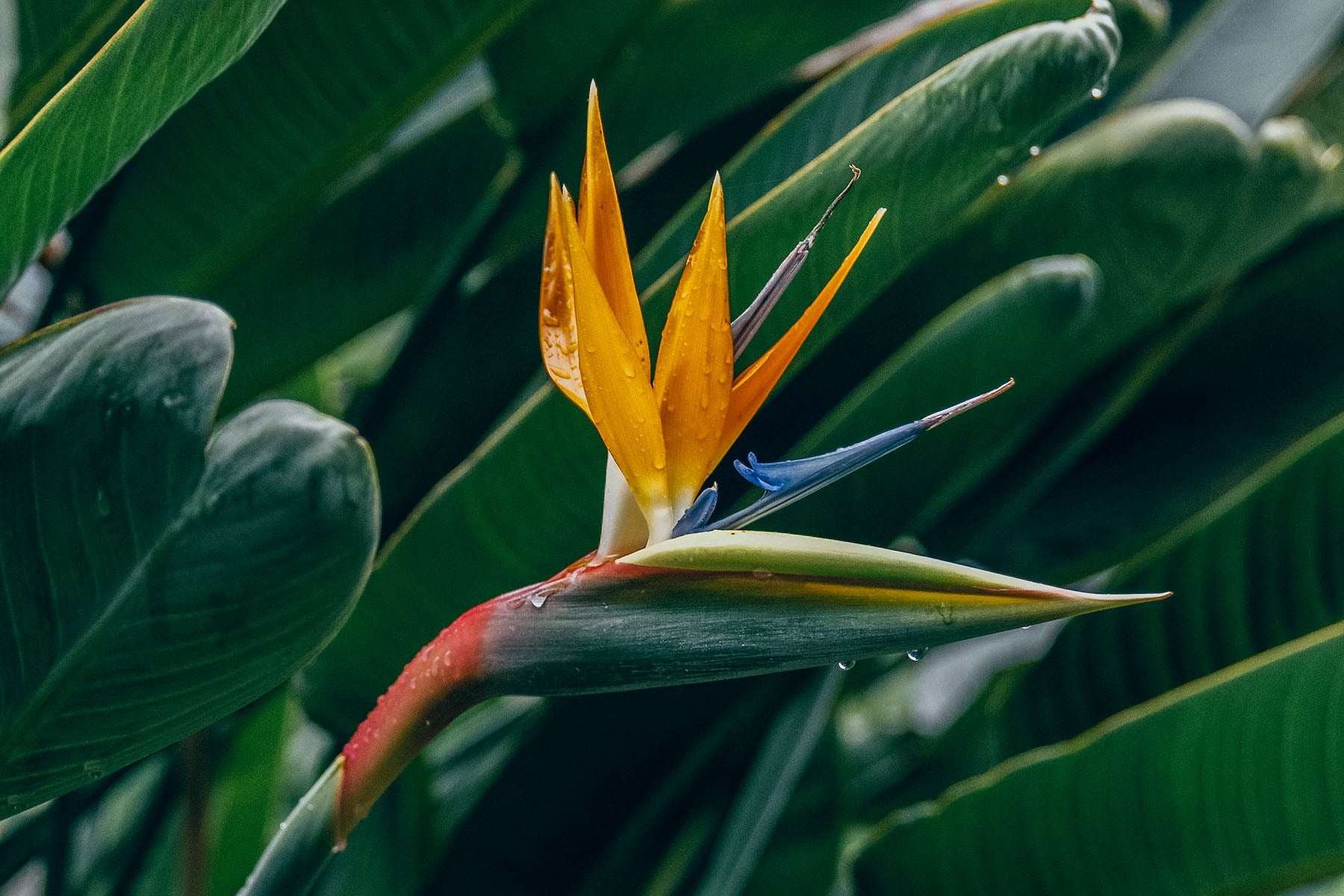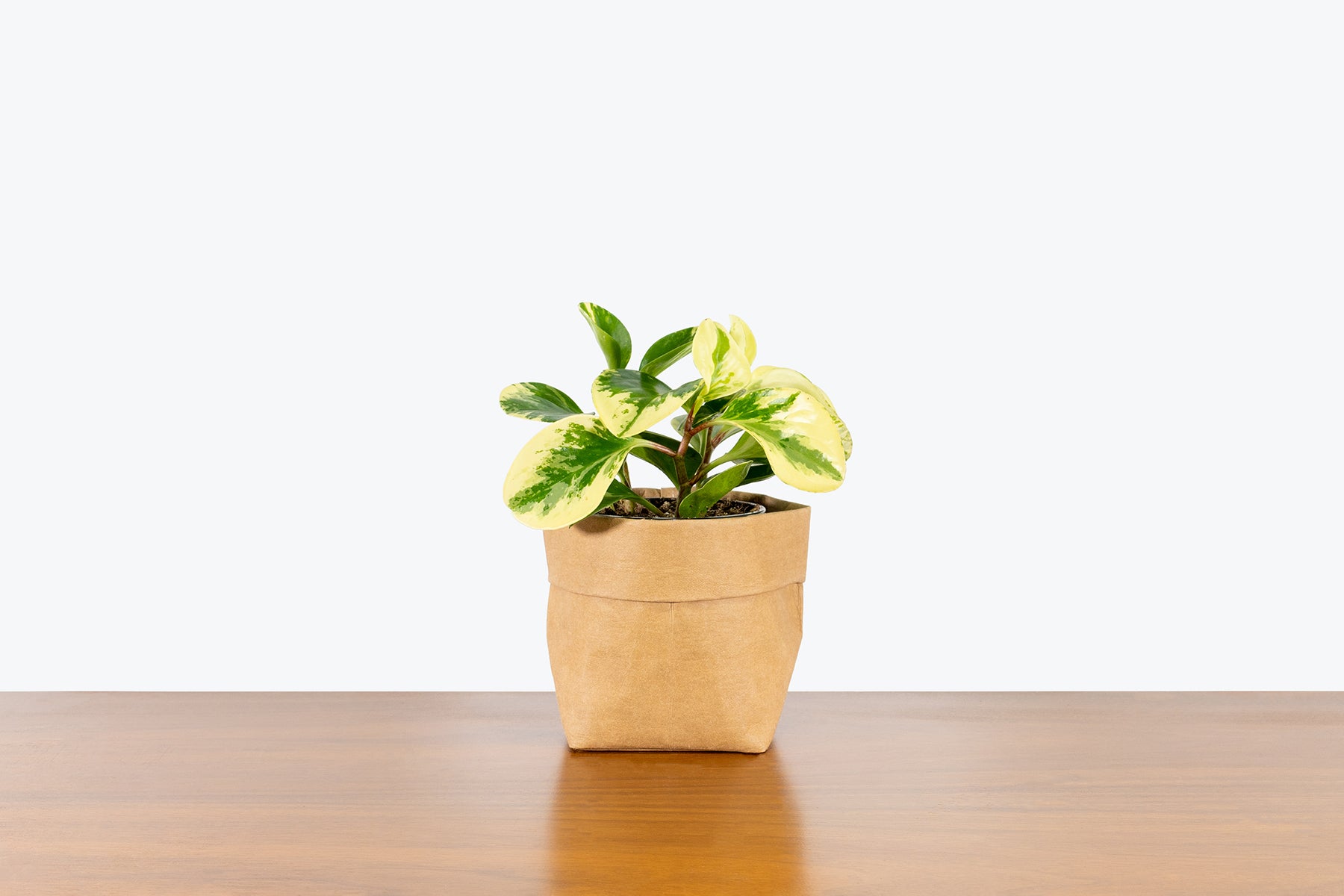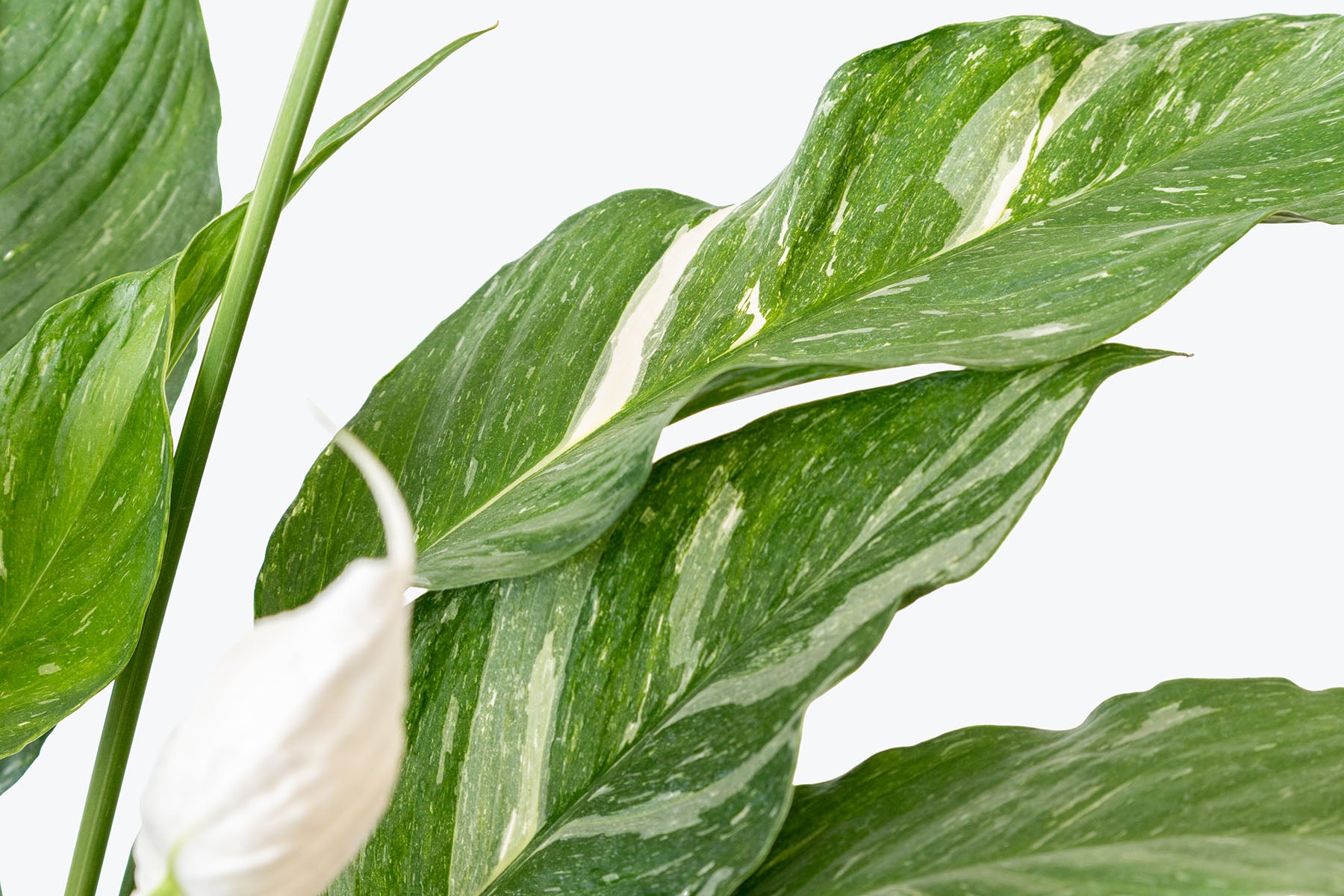
How to Take Care of Your Bird of Paradise
The plant that can bring the ultimate tropical vibe to your home, the queen of houseplants, the most impressive of all. An exotic and visually stunning plant originating in Africa, Bird of Paradise are often confused for Banana plants, with their broad, arching leaves, but they have more of a fountain shape, rather than the spiral of Bananas. Now an incredibly popular houseplant, you would be hard-pressed to not find them appearing in architectural magazines or beautifully designed homes, as their leaves make such an impressive statement and they truly green up a space.

Their flowers, which range from the striking orange and purple of the Strelitzia Reginae, or Orange Bird of Paradise, to the beautiful hues of cream and blue of the Strelitzia Nicolai, or White Bird of Paradise, to golden-yellow flowers of Strelitzia reginae 'Mandela's Gold', or Bird of Paradise Mandela Gold, are where they get their name from. Similar to the avian birds of paradise that live in tropical forests, the plant form loves those tropical conditions, including bright light and high humidity. They are fairly adaptable but will flourish in a sunny location, with their large leaves absorbing all that glorious light. Indoors, they can grow anywhere from 3 - 10 feet tall, of course growing faster and fuller with higher light.
One observance about these tropical stunners is that their leaves will naturally split over time, due to a few factors:
Light:
They have evolved over time to split in order to allow light through to the lower portion of the plant otherwise, those newer, larger leaves would hog all the precious light.
Wind:
In the wild, the splits allow the wind to move through the plant without bending, breaking, or snapping the foliage of this top-heavy plant. While this is reduced by keeping a plant indoors, it is still completely natural and will occur over time.
Humidity:
The lower the humidity is, the more the leaves will split, usually. Although your plant will do just fine in household humidity, increase the humidity around the plant, by misting or using a humidifier, to keep the splitting to a minimum. Avoid keeping your plant in any drafts though.
This happens a little more often with the White Bird of Paradise as their leaves are much larger and broader than the Orange Bird of Paradise leaves. Remember that no plant is ever going to stay looking as it did when it was originally grown in a greenhouse and now has to adjust to your home. We have to be realistic in our expectations of plants as they adjust to our homes and love them as they are! Thankfully, Birds of Paradise make it quite simple to love and care for them, follow our guidelines below to find out how to do so.
Light Requirements
Although they can adapt to medium light conditions, Birds of Paradise will flourish in very, very bright light, including direct sunlight. For the long term, you will want to keep your plant in lots of bright light, as they will not thrive in lower light levels without adequate sunlight. When considering where to place your Bird of Paradise, use the following example spaces as a guideline:
- Directly next to a West facing window (if there is a lot of direct sun for more than 3 hours, consider placing a sheer blind or pulling the plant slightly back as too much sun can cause burn)
- Directly next to a South or East facing window that has no blinds, where it will receive lots of morning sunlight
- A small distance (no more than 3 ft.) back from a West facing window that has no blinds
- In a brightly lit room, potentially under a skylight, where the room/plant gets a lot of indirect (or direct), bright light
🚨
If you are keeping your plant in a location that receives direct sun through a window, remember that it needs to go through an adjustment period. Do not place it in a spot that receives prolonged sun right away! The foliage will most likely burn or become scorched as the majority of plants are grown under shade cloths in a greenhouse. Give the plant an hour more of sun every week until the plant is in the spot you want it.
Noticing a spear-like object protruding from the center of a clump of Bird of Paradise leaves? What you are seeing is a new leaf being produced! The newest growth comes from the center of each clump and slowly, but surely, it will unfurl and be a stunning, large, shiny, new leaf. Resist the urge to assist it while it unfurls, as this can cause it to rip more than it would do naturally, just mist it a bit to help the unravelling go a little smoother.

Keep an eye on your plant as it adapts to the new home it is in, if it is happy and producing lots of new growth during the warmer months, leave it where it is as you don't want to mess with a good thing. If the plant never seems to grow or produces unhealthy growth, not for any other reason, consider moving your plant to a location that receives brighter light. If the leaves are getting scorched and receiving too much direct light, consider moving the plant further back from the window or getting sheer blinds. The plant will most likely go through a period of dormancy during the cooler months so do not fret if you don't see lots of new growth all the time, and they do take a while to form new leaves. Just keep them in that nice, bright light!
🌸
One of the initial reasons people want to get a Bird of Paradise is for their flowers, but in order for them to flower, a lot of patience, time, and consistently perfect conditions are necessary. See what we recommend doing below in the final section of this care guide if you would like to know what those conditions are, but don't get your hopes up as it is very rare for them to flower indoors.
Birds of Paradise actually prefer to be root bound, where they will produce lots of healthy growth if given enough light. We suggest repotting every 18-24 months for larger floor plants, into a pot about 2-4" larger than its current home, although you could hold off for 28 months if the plant is in prime condition and growing happily. If you prefer to maintain the size of the pot, repot it into the same vessel but provide fresh, rich, well-draining soil and trim away any old roots or foliage. See more about our repotting guides here.
Watering Requirements
When the top half of the soil is dry, soak the soil thoroughly, ensuring all of the soil is getting wet and providing water to the roots. If it is going through too quickly, aerate the soil so that it will disperse evenly throughout the soil. Birds of Paradise can handle slightly drying out a bit more as well, as you don't want to give them water more often than needed, especially during the cooler winter months when new growth slows. After watering, get rid of any excess water so that your plant does not sit in any standing water as that will lead to root rot.
△ 6" Bird of Paradise White Nicolai
If you really feel like spoiling your plant, (which you should do every once in a while obviously!) use rainwater, distilled water, or tap water that has sat out overnight to water your plant. Rainwater has a lot of micronutrients that water straight from the tap just doesn’t contain. Using solely tap water can also cause a build-up of chlorine and other chemicals in your plant’s soil over time so it’s generally a good rule of thumb to flush the soil every once in a while. These chemicals can also lead to browning or yellowing foliage.
When the days turn cooler and darker, you will need to water your plant less often than the brighter, warmer months, so let your plant's soil dry out a little during those months. Showering your plant is another great idea as this can wash off any dust or potential pests that have accumulated on them. Also, if your plant is receiving very bright light, it will need more water than the plant that is receiving medium light.
Humidity
Even though they can survive in our basic home humidity, they love a warm, humid environment! If you are willing to spend the extra money and effort, here are some ways you can increase the humidity in the air around your beautiful Bird:
- Mist the leaves daily or weekly to increase the ambient humidity around the plant (weekly should be fine, if problems occur, check the list at the end of this article to find a potential solution)
- Place the nursery pot on top of a bed of rocks that are covered in water, which increases the humidity in the air around the plant
- Invest in a humidifier and keep it near your plant
If you notice an excessive amount of splits in your plant's leaves, or the new leaves are not unravelling very well, mist your plant more often or increase the humidity in the ways mentioned above. Finally, avoid placing a Bird of Paradise anywhere near a draft, such as cool open windows, heating vents, or air conditioners, because although they love a warm room, they are sensitive to temperature changes and dry, blowing air!
Fertilizing
Birds of Paradise can be quite prolific growers when they are happy with their location and have adjusted to your home! Knowing this, it is important that you feed your plant appropriately. A regular, all-purpose, organic liquid fertilizer given to your plant once a month in the spring and summer will be perfectly fine. They do go dormant during the winter so hold off fertilizing again until the following spring.
Toxicity
There is a consensus is that this plant is generally safe, as some reports state that it is not toxic. That being said, if a small portion of the plant was ingested, by a human or a pet, the effects would likely be mild. But a large piece could be a choking hazard for a child and if too much plant material is swallowed, that can cause gastrointestinal symptoms (cramps, nausea, diarrhea, or vomiting) which, although mild, can lead to dehydration. We always recommend not letting your children or pets munch on your houseplants.
Common Pests & Problems
Generally, Birds of Paradise are quite problem-free, as long as you have a consistent environment, care schedule, and they receive some nice, bright light. However, there are a few problems you could run into if you are not on top of pests or your watering. Here are the most common issues your may experience:
Scale:
If you notice a sticky, honeydew-like sap on the bottoms of leaves and brown “bumps” along the stems, you may be experiencing scale. Their damage includes yellowing and damaged leaves (old and new) with unhealthy new growth. Remove any bugs with a soft cloth dipped in rubbing alcohol and then treat the whole plant with insecticidal soap or horticultural oil, just make sure you treat your plant every 10 days until there are no more signs of them. You can read more about how to get rid of scale here.
Mealybug:
If you notice clumps of white fuzz throughout the plant and small white mounds, you may be experiencing mealybugs. Wash the plant off and allow the leaves and stems to dry off, then treat the entire plant (stems included!) with a Neem oil mix or an insecticidal soap spray you can get from your local garden centre or plant shop. You can read more about how to get rid of mealybugs here.
Over-watering:
When the older leaves on your plant are yellowing, while remaining slightly soft (not due to bugs or age), or the edges of leaves are turning a brown lined with yellow, this may be a sign that your plant is receiving too much water. Allow the soil to dry out and then water as I described above. In the worst case, you may have to repot your plant into fresh soil and dispose of any rotted roots to bring your plant back to health.
Under-watering:
When the leaves on your plant are curling inward, or the edges and tips are crisping up (not due to bugs or age), this may be a sign that you are underwatering. Up your watering little by little until your plant is content and showing healthy signs like new growth or upright, flattened leaves.
Excessive Splitting:
Although some splitting is completely natural, if your plant's leaves are splitting excessively, try increasing the humidity and make sure the plant is receiving the bright light that it needs.
Leaf Curl:
If your plant's leaves are curling, this could be from lack of soil moisture, low humidity, not enough light, water quality, or temperature of the room in which the plant is kept. Make sure you are following all parts of our care guide outlined above and adjust anything that may not be following what we recommend.
Final Notes
Finally, let's discuss the blooming process of Birds of Paradise. As we mentioned previously, do not purchase one of these plants for their blooms, as it is very rare that they bloom indoors. Generally, there is not enough moisture or light indoors to trigger the blooming process. If you would like to try to get yours to bloom, we recommend following these next steps (to reiterate, it is very rare that your plant will bloom):
Patience & Consistency:
The plant must reach maturity (depending on the plant this could be anywhere from 5-10 years) and have its native conditions met - think warm, humid, and sunny.
Restriction:
Keep your plant snug and restricted in its pot, they need to be root-bound if there is any hope of a flower. They require consistent, undisturbed, ideal conditions and if their roots are disturbed in any way, the plant may not bloom again for another 2-3 years. Since the overall plant grows best in a root-bound home, it is ideal to always have your plant a little root-bound anyways.
Light:
The most common reason they don't flower is that they don't get enough light (they need 4-6 hours of sunlight a day)
Moisture:
Keep the soil evenly moist in the spring and summer months, then allow it to dry out bit more between waterings in the winter months
Fertilizer:
Make sure to feed your plant consistently in the spring and summer months
With all that being said, enjoy your beautiful Bird of Paradise as they truly do provide an amazing payoff when they are happy, even if we can't get them to bloom indoors.







